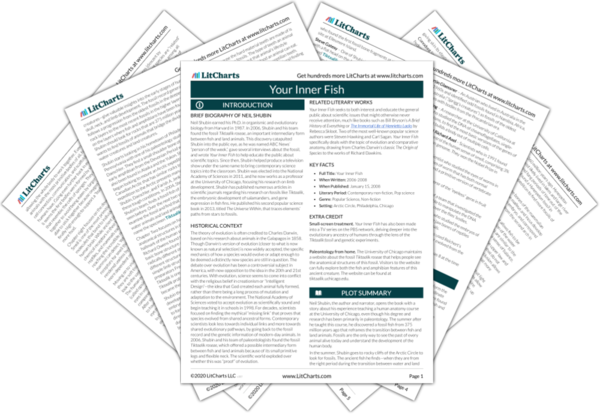After noting the similarities between different animal species, Shubin explains how studying the anatomy of simple animals can provide a tool to understand how the anatomy of complex animals works. This approach takes advantage of the ways that these animals are similar as a starting point to focus on the ways that species differ. Shubin uses the anatomy of relatively “simple” animals such as fish, sponges, or bacteria to make it easier to understand what is going on in the more “complex” animals like primates and humans. He then further breaks down the complicated human anatomy by organizing the book into chapters on different parts (teeth, heads, ears, eyes, hands, etc.), tightly focusing on just one part at a time make it easier to see how the entire body comes together in the end. Shubin follows the complex functions of each of these organs or body parts through the “simple” versions of these anatomical structures to make it easier to see why such complicated systems developed the way they did. For example, the complex human eye uses the same light gathering molecules (opsin) as bacteria do. Scientists can run experiments on bacteria to better understand how opsin works that would be impossible to do on a human eye due to all the variables in human vision. Then scientists can apply what they now know about bacterial opsin to human opsin and have a clearer picture of what the human eye is actually doing. Simple animals are a gateway towards studying the more complex animals, because the complex animals utilize many of the parts of simple animals and add to their body structures instead of creating completely different systems.
Aside from using simple animals to make it easier to understand complex animals, Shubin also uses simple analogies to help people understand complex concepts. As Your Inner Fish is a scientific book written for the general public, Shubin uses many tools to help ensure that the average person can easily grasp the sometimes-heavy scientific topics that he has made his life’s work. For example, Shubin illustrates the concept of descent with modification through a family of clowns who only gain one new trait in each child, simplifying the idea of human generations that change multiple things from parent to child. Yet though he simplifies complex concepts to make them easier to understand at first, Shubin does not advocate for reducing complex concepts to their simplest roots and leaving it at that. Once he has simplified the concept and explained it thoroughly, he adds the layers of complexity back. These simple analogies or illustrations are a tool to help the larger public get interested in these topics and attain a basic understanding. Shubin then expresses the hope that his readers will continue to learn more about these scientific concepts, and he includes a large list of resources for further reading that go deeper into complicated topics of genetic research or medical issues.
Understanding Complex Concepts Through Simple Analogies ThemeTracker

Understanding Complex Concepts Through Simple Analogies Quotes in Your Inner Fish
If you want to understand the wiring and plumbing in my building, you have to understand its history, how it was renovated for each new generation of scientists. My head has a long history also, and that history explains complicated nerves like the trigeminal and the facial.

Unlock explanations and citation info for this and every other Your Inner Fish quote.
Plus so much more...
Get LitCharts A+What I've just given you is one of the big tricks for understanding the most complicated cranial nerves and large portions of the head. When you think trigeminal nerve, think first arch. Facial nerve, second arch.
Mangold had discovered a small patch of tissue that was able to direct other cells to form an entire body plan. The tiny, incredibly important patch of tissue containing all this information was to be known as the Organizer… Today, many scientists consider Mangold's work to be the single most important experiment in the history of embryology.
Take the entire 4.5-billion-year history of the earth and scale it down to a single year, with January 1st being the origin of the earth and midnight on December 31st being the present. Until June, the only organisms were single-celled microbes, such as algae, bacteria, and amoebae. The first animal with a head did not appear until October. The first human appears on December 31st. We, like all the animals and plants that have ever lived, are recent crashers at the party of life on earth.
Our eyes have a history as organs, but so do eyes' constituent parts, the cells and tissues, and so do the genes that make those parts. Once we identify these multiple layers of history in our organs, we understand that we are simply a mosaic of bits and pieces found in virtually everything else on the planet.
This law is so profound that most of us take it completely for granted. Yet it is the starting point for almost everything we do in paleontology, developmental biology, and genetics.
This biological "law of everything" is that every living thing on the planet had parents.
Replace this family circus with real features - genetic mutations and the body changes that they encode - and you have a lineage that can be identified by biological features. If descent with modification works this way, then our family trees have a signature in their basic structure... Obviously, the real world is more complex than our simple hypothetical example. Reconstructing family trees can be difficult if traits arise many different times in a family… or if traits do not have a genetic basis and arise as the result of changes in diet or other environmental conditions.











